|
Long ago, an ancient sea covered most of the southwestern United States. It was during this time that layers of gypsum were deposited on the seafloor. The rise and fall of the sea level millions of years ago started the process of making the gypsum sand that covers the monument today. Many factors, including the latest ice age, had an effect on the formation of this magnificent landscape. The following journey through time shows the gradual transformation from sea to sand, and the amazing factors that allow this dune-field to exist.
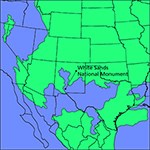
NPS Photo 280 to 250 million years agoDuring this era, the earth’s continents were joined together in one massive mega-continent, known as Pangaea. Part of the southwestern United States, including what is now southern New Mexico, was covered by a shallow sea, known as the Permian Sea. Over millions of years, rising and falling sea levels left behind thick layers of mineral gypsum and other dissolved minerals on the seafloor. 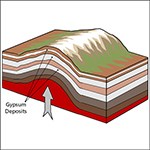
NPS Photo 70 million years agoAs the earth’s tectonic plates started to shift and collide, the pressure from these movements pushed up land, eventually creating many of our modern-day mountain ranges, including the Rocky Mountains and the mountains surrounding the area that is home to the park today. 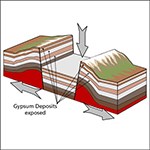
NPS Photo 30 million years agoEventually, the tectonic plates began to pull apart in opposite directions, causing the development of numerous fault zones. Large portions of mountain ranges were sometimes split apart, causing sections of the Earth’s crust to drop thousands of feet, forming basins along these faults. Around this time the mountains in this area split into two distinct ranges; the San Andres Mountains to the west and the Sacramento Mountains to the east. Between these two mountain ranges the Tularosa basin formed. 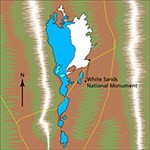
NPS Photo 24,000-12,000 years agoDuring the last Ice Age 40,000 to 12,000 years ago, the climate was much colder and wetter. As the climate started to warm around 11,000 years ago rain and snowmelt carried dissolved gypsum from the surrounding mountain ranges into the basin. The gypsum runoff settled in Lake Otero. With the ending of the last Ice Age, about 12,000 years ago, Lake Otero began to evaporate, becoming a playa, or dry lake bed. 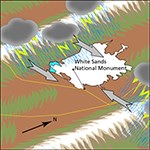
NPS Photo 10,000 years ago to present – formation of the dunefieldAs the climate became warmer and drier, the effects of sun and wind slowly began transforming this area into the modern Chihuahuan Desert. Most of Lake Otero dried up. The dry portions of the lakebed became what we know today as Alkali Flat, while the smaller seasonal playa that remained formed modern Lake Lucero. As Lake Otero’s water disappeared selenite crystals formed on Alkali Flat. Strong 17 mph winds carried the smaller pieces, further breaking down the crystals into small grains and polishing them into a brilliant white color. 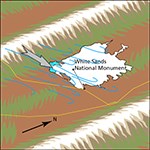
NPS Photo Present DayPresently, rain and snow-melt from the surrounding mountains and upwelling from deep water within the basin periodically filling Lake Lucero with water containing dissolved gypsum. When the lake water evaporates, small selenite crystals (2 cm to 3 cm) formed on the surface of Lake Lucero and Alkali Flat just as they have for thousands of years. Most of the crystal formation occurs when large floods concentrate the mineralized water every 10 to 14 years. Wind and water break down these crystals into progressively smaller and smaller particles until they are fine grains of white gypsum sand and eventually dust. |
Last updated: January 22, 2020
